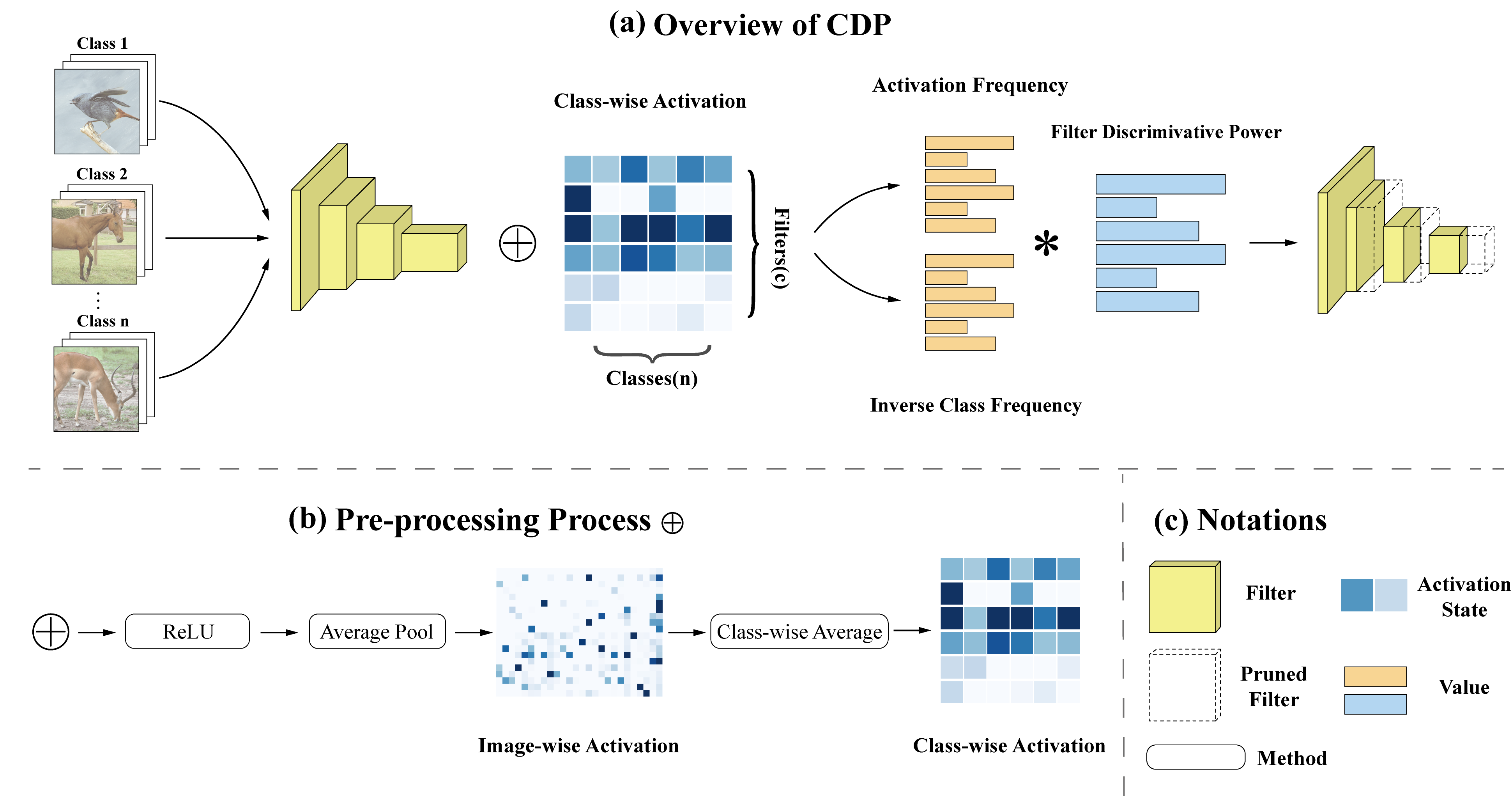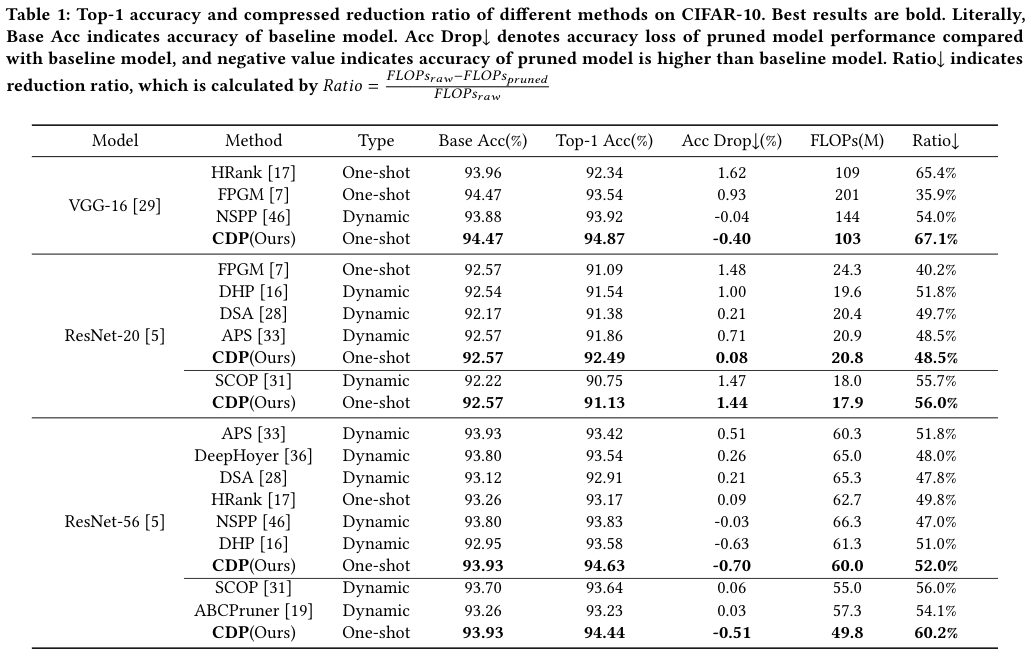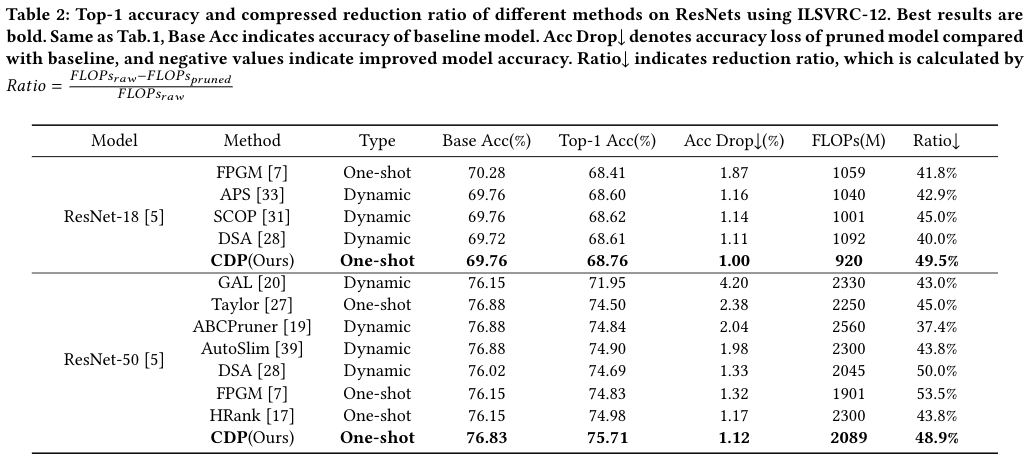CDP: Towards Optimal Filter Pruning via Class-wise Discriminative Power (ACM MM '21)
[Paper]
We proposed a novel filter pruning strategy via class-wise discriminative power (CDP). CDP quantizes the discriminative power by introducing the Term Frequency-Inverse Document Frequency (TF-IDF) into deep learning to quantize filters across classes. Specifically, CDP regards the output of a filter as a word and the whole feature map as a document. TF-IDF is used to generate the relevant score between the words (filters) and all documents (classes), i.e., filters that always have low TF-IDF scores are less discriminative and thus need to be pruned. In particular, CDP does not require any iterative training or search process, which is simple and straight forward.
Requirements
Environment
- python 3.6
- pytorch 1.7.0
- torchvision 0.7.0
- NNI 2.0
Datasets
CIFAR-10
ImageNet
Performance
CIFAR-10
| Model | FLOPs(M) | Base FLOPs(M) | Accuracy(%) | Baseline Acc(%) | MindSpore |
|---|---|---|---|---|---|
| VGG16 | 103.3 | 313.5 | 94.87 | 94.47 | Link |
| ResNet20 | 20.76 | 40.6 | 92.49 | 92.57 | Link |
| ResNet56 | 60.02 | 125 | 94.63 | 93.93 | |
| ResNet56 | 49.84 | 125 | 94.44 | 93.93 |
ImageNet
| Model | FLOPs(M) | Base FLOPs(M) | Accuracy(%) | Base Acc(%) |
|---|---|---|---|---|
| ResNet18 | 920 | 1820 | 68.76 | 69.76 |
| ResNet50 | 2089 | 4089 | 75.71 | 76.83 |
Running
There are three parts in our experiments:
- Record feature maps generated by models based on sampled data
- Use feature maps to create CDP pruner, and execute pruning
- Retrain pruned models
CIFAR10
Because the scale of cifar10 is relatively small and the computation cost of statistical characteristic graph is small, we directly complete three parts in one file.
python prune_cifar.py \
--model resnet20 \ # select model
--pretrained_dir "./ckpt/base/resnet20_model_best.pth.tar" \
--dataroot "/gdata/cifar10/" \ # dataset dir
--gpus 0,1 \ # denote which gpu to use
-j 4 \ # set number of dataloder worker
--stop_batch 200 \ # set batch number of sampled data
--sparsity 0.5 # set the sparsity of model != reduced_flops_ratio
# --coe 0 \ # hyper parameter of CDPOther parameters are listed in prune_cifar.py.
ImageNet
Because of the large scale of Imagenet and the high computation cost of statistical characteristic graph, we carried out the experiment in two steps
First, accumulate feature maps and prune the model.
python statistic_imagenet.py \
--model resnet50 \
--pretrained_dir "./ckpt/base/resnet50_model_best.pth.tar" \
--dataroot "/gdata/image2012/" \ # path to dataset
--gpus 0,1 \
-j 4 \ # Number of dataloader worker
--stop_batch 200\ # Number of sampled data
--sparsity 0.5 \ # Sparsity of modelOther parameters are listed in statistic_imagenet.py.
Second, retrain the pruned model
cd ./imagenet
python imagenet.py \
--model resnet50 \
--resume "./ckpt/resnet50_s4.pth" \
--dataroot "/gdata/image2012/" \
--gpus 0,1 \
-j 4 \
--batch-size 128 \
--epochs 200\
--make-mask \
--warmup 1 \
--label-smoothing 0.1 \Other parameters are listed in imagenet.py.
License
The entire code is under the MIT License
Citation
@inproceedings{xu2021cdp,
title={CDP: Towards Optimal Filter Pruning via Class-wise Discriminative Power},
author={Xu, Tianshuo and Wu, Yuhang and Zheng, Xiawu and Xi, Teng and Zhang, Gang and Ding, Errui and Chao, Fei and Ji, Rongrong},
booktitle={Proceedings of the 29th ACM International Conference on Multimedia},
pages={5491--5500},
year={2021}
}[1] Tianshuo Xu, Yuhang Wu, Xiawu Zheng, Teng Xi, Gang Zhang, Errui Ding,Fei Chao, and Rongrong Ji. 2021. CDP: Towards Optimal Filter Pruningvia Class-wise Discriminative Power. InProceedings of the 29th ACM Int’lConference on Multimedia (MM ’21), Oct. 20–24, 2021, Virtual Event, China.ACM, New York, NY, USA, 10 pages. https://doi.org/10.1145/3474085.3475680


